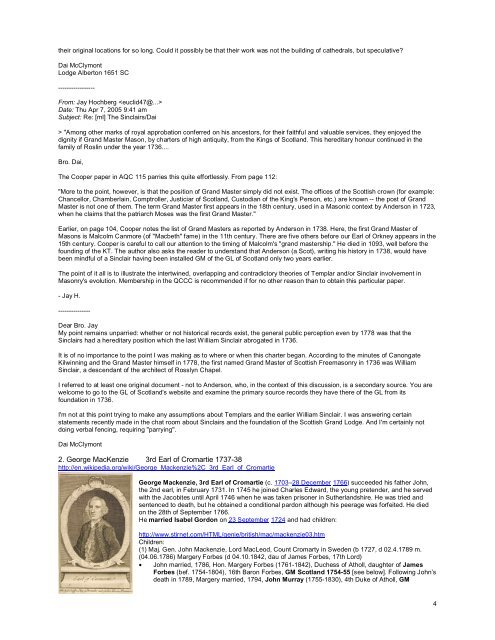Grand Masters of Scotland - Onondaga and Oswego Masonic ...
Grand Masters of Scotland - Onondaga and Oswego Masonic ...
Grand Masters of Scotland - Onondaga and Oswego Masonic ...
You also want an ePaper? Increase the reach of your titles
YUMPU automatically turns print PDFs into web optimized ePapers that Google loves.
their original locations for so long. Could it possibly be that their work was not the building <strong>of</strong> cathedrals, but speculative?<br />
Dai McClymont<br />
Lodge Alberton 1651 SC<br />
-----------------<br />
From: Jay Hochberg <br />
Date: Thu Apr 7, 2005 9:41 am<br />
Subject: Re: [ml] The Sinclairs/Dai<br />
> "Among other marks <strong>of</strong> royal approbation conferred on his ancestors, for their faithful <strong>and</strong> valuable services, they enjoyed the<br />
dignity if <strong>Gr<strong>and</strong></strong> Master Mason, by charters <strong>of</strong> high antiquity, from the Kings <strong>of</strong> <strong>Scotl<strong>and</strong></strong>. This hereditary honour continued in the<br />
family <strong>of</strong> Roslin under the year 1736....<br />
Bro. Dai,<br />
The Cooper paper in AQC 115 parries this quite effortlessly. From page 112:<br />
"More to the point, however, is that the position <strong>of</strong> <strong>Gr<strong>and</strong></strong> Master simply did not exist. The <strong>of</strong>fices <strong>of</strong> the Scottish crown (for example:<br />
Chancellor, Chamberlain, Comptroller, Justiciar <strong>of</strong> <strong>Scotl<strong>and</strong></strong>, Custodian <strong>of</strong> the King's Person, etc.) are known -- the post <strong>of</strong> <strong>Gr<strong>and</strong></strong><br />
Master is not one <strong>of</strong> them. The term <strong>Gr<strong>and</strong></strong> Master first appears in the 18th century, used in a <strong>Masonic</strong> context by Anderson in 1723,<br />
when he claims that the patriarch Moses was the first <strong>Gr<strong>and</strong></strong> Master."<br />
Earlier, on page 104, Cooper notes the list <strong>of</strong> <strong>Gr<strong>and</strong></strong> <strong>Masters</strong> as reported by Anderson in 1738. Here, the first <strong>Gr<strong>and</strong></strong> Master <strong>of</strong><br />
Masons is Malcolm Canmore (<strong>of</strong> "Macbeth" fame) in the 11th century. There are five others before our Earl <strong>of</strong> Orkney appears in the<br />
15th century. Cooper is careful to call our attention to the timing <strong>of</strong> Malcolm's "gr<strong>and</strong> mastership." He died in 1093, well before the<br />
founding <strong>of</strong> the KT. The author also asks the reader to underst<strong>and</strong> that Anderson (a Scot), writing his history in 1738, would have<br />
been mindful <strong>of</strong> a Sinclair having been installed GM <strong>of</strong> the GL <strong>of</strong> <strong>Scotl<strong>and</strong></strong> only two years earlier.<br />
The point <strong>of</strong> it all is to illustrate the intertwined, overlapping <strong>and</strong> contradictory theories <strong>of</strong> Templar <strong>and</strong>/or Sinclair involvement in<br />
Masonry's evolution. Membership in the QCCC is recommended if for no other reason than to obtain this particular paper.<br />
- Jay H.<br />
---------------<br />
Dear Bro. Jay<br />
My point remains unparried: whether or not historical records exist, the general public perception even by 1778 was that the<br />
Sinclairs had a hereditary position which the last William Sinclair abrogated in 1736.<br />
It is <strong>of</strong> no importance to the point I was making as to where or when this charter began. According to the minutes <strong>of</strong> Canongate<br />
Kilwinning <strong>and</strong> the <strong>Gr<strong>and</strong></strong> Master himself in 1778, the first named <strong>Gr<strong>and</strong></strong> Master <strong>of</strong> Scottish Freemasonry in 1736 was William<br />
Sinclair, a descendant <strong>of</strong> the architect <strong>of</strong> Rosslyn Chapel.<br />
I referred to at least one original document - not to Anderson, who, in the context <strong>of</strong> this discussion, is a secondary source. You are<br />
welcome to go to the GL <strong>of</strong> <strong>Scotl<strong>and</strong></strong>'s website <strong>and</strong> examine the primary source records they have there <strong>of</strong> the GL from its<br />
foundation in 1736.<br />
I'm not at this point trying to make any assumptions about Templars <strong>and</strong> the earlier William Sinclair. I was answering certain<br />
statements recently made in the chat room about Sinclairs <strong>and</strong> the foundation <strong>of</strong> the Scottish <strong>Gr<strong>and</strong></strong> Lodge. And I'm certainly not<br />
doing verbal fencing, requiring "parrying".<br />
Dai McClymont<br />
2. George MacKenzie 3rd Earl <strong>of</strong> Cromartie 1737-38<br />
http://en.wikipedia.org/wiki/George_Mackenzie%2C_3rd_Earl_<strong>of</strong>_Cromartie<br />
George Mackenzie, 3rd Earl <strong>of</strong> Cromartie (c. 1703–28 December 1766) succeeded his father John,<br />
the 2nd earl, in February 1731. In 1745 he joined Charles Edward, the young pretender, <strong>and</strong> he served<br />
with the Jacobites until April 1746 when he was taken prisoner in Sutherl<strong>and</strong>shire. He was tried <strong>and</strong><br />
sentenced to death, but he obtained a conditional pardon although his peerage was forfeited. He died<br />
on the 28th <strong>of</strong> September 1766.<br />
He married Isabel Gordon on 23 September 1724 <strong>and</strong> had children:<br />
http://www.stirnet.com/HTML/genie/british/mac/mackenzie03.htm<br />
Children:<br />
(1) Maj. Gen. John Mackenzie, Lord MacLeod, Count Cromarty in Sweden (b 1727, d 02.4.1789 m.<br />
(04.06.1786) Margery Forbes (d 04.10.1842, dau <strong>of</strong> James Forbes, 17th Lord)<br />
• John married, 1786, Hon. Margery Forbes (1761-1842), Duchess <strong>of</strong> Atholl, daughter <strong>of</strong> James<br />
Forbes (bef. 1754-1804), 16th Baron Forbes, GM <strong>Scotl<strong>and</strong></strong> 1754-55 [see below]. Following John’s<br />
death in 1789, Margery married, 1794, John Murray (1755-1830), 4th Duke <strong>of</strong> Atholl, GM<br />
4







![Richard [Nicholls] Harison / Harrison - Onondaga and Oswego ...](https://img.yumpu.com/24950065/1/190x245/richard-nicholls-harison-harrison-onondaga-and-oswego-.jpg?quality=85)

![Richard [Nicholls] Harison / Harrison - Onondaga and Oswego ...](https://img.yumpu.com/24950063/1/190x245/richard-nicholls-harison-harrison-onondaga-and-oswego-.jpg?quality=85)







